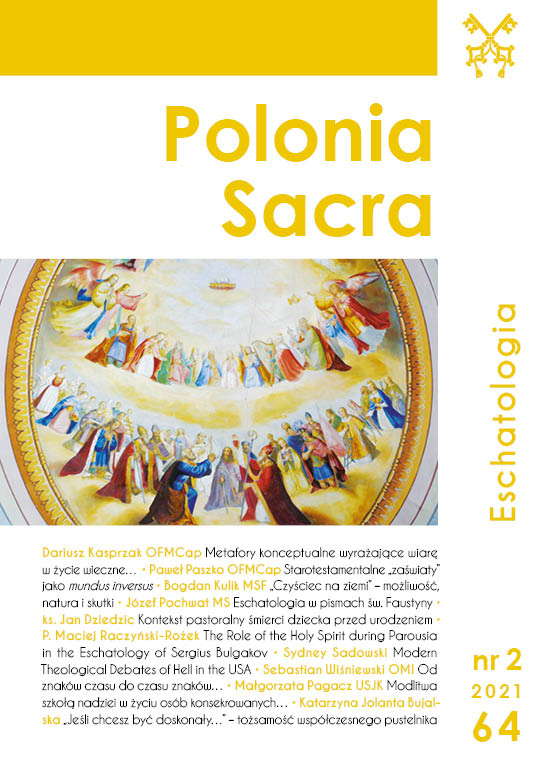Starotestamentalne „zaświaty” jako mundus inversus
DOI:
https://doi.org/10.15633/ps.3979Słowa kluczowe:
Stary Testament, życie pośmiertne, „świat na opak”, hermeneutyka biblijnaAbstrakt
Poglądy starożytnych na temat życia pozagrobowego mogą być poddawane wielorakim interpretacjom. Niniejszy artykuł prezentuje wyobrażenia o „zaświatach” obecne w Starym Testamencie na tle uniwersalnej koncepcji, zwanej mundus inversus, czyli „świat na opak”. Idea ta nie tylko dobrze nadaje się do ukazania w szerszej perspektywie kulturowej poszczególnych fragmentów biblijnych, ale dzięki swej powszechności i interdyscyplinarnemu charakterowi może stanowić punkt wyjścia w poszukiwaniu nowych kierunków interpretacji biblijnej. Życie pozagrobowe powszechnie jawi się człowiekowi jako „świat odwrócony do góry nogami”.
Bibliografia
Assmann J., Literatur und Karneval im Alten Ägypten, w: Karnevaleske Phänomene in antiken und nachantiken Kulturen und Literaturen, Hrsg. S. Döpp, Trier 1993, s. 31–57 (Bochumer Altertumswissenschaftliches Colloquium, 13).
Babcock B.A., Introduction, w: The Reversible World. Symbolic Inversion in Art and Society, ed. B.A. Babcock, Ithaca–London 1978, s. 13–36 (Symbol, Myth and Ritual).
Barillari S.M., Introduzione, w: Immagini dell’aldilà, a cura di S.M. Barillari, Roma 1998, s. 7–26.
Basson A., „Only ruins remain”. Psalm 74 as a Case of „Mundus Inversus”, „Old Testament Essays” 20 (2007) no. 1, s. 128–137.
Chegodaev M., Lest One Be Turned Upside Down, „Discussions in Egyptology” 40 (1998), s. 67–80.
Cocchiara G., Il mondo alla rovescia. I primi studi sul folklore, la cultura e irrazionale e sul rovesciamento dissacrante della realtà, Torino 1981 (Universale Scientifica, 218/219).
Colie R.L., Paradoxia Epidemica. The Renaissance Tradition of Paradox, Princeton 1966.
Durkheim E., Mauss M., Primitive Classification, transl. R. Needham, London 19692.
Freud S., Gesammelte Werke chronologisch geordnet, Bd. 11: Vorlesungen zur Einführung in die Psychoanalyse, London 1940.
Gadamer H.-G., Die verkehrte Welt, w: Hegel-Tage Royaumont 1964. Beiträge zur Deutung der Phänomenologie des Geistes, Hrsg. H.-G. Gadamer, Bonn 1966, s. 135–154 (Hegel-Studien, 3).
Hegel G.W.F., Phänomenologie des Geistes, Berlin 1832.
Herodot, Dzieje, tłum. S. Hammer, Warszawa 2007.
Hill C., The World Turned Upside Down. Radical Ideas During the English Revolution, Harmondsworth 1975.
Janowski B., Konfliktgespräche mit Gott. Eine Anthropologie der Psalmen, Neukirchen-Vluyn 2003.
Jebens H., Cargo-Kulte und Holy Spirit Movements. Zur Veränderungs- und Widerstandsfähigkeit der traditionalen Religion in Hochland von Papua-Neuguinea, „Anthropos” 85 (1990), s. 403–413.
Jebens H., Verkehrte Welt, w: Handbuch religionswissenschaftlicher Grundbegriffe, Hrsg. H. Cancik, B. Gladigow, K.-H. Kohl, Bd. 5, Stuttgart 2001, s. 323–327.
Johnston P.S., Cienie Szeolu. Śmierć i zaświaty w biblijnej tradycji żydowskiej, tłum. P. Sajdek, Kraków 2010.
Kenner H., Das Phänomen der verkehrten Welt in der klassischen Antike, „Forschungen und Fortschritte” 41 (1967), s. 11–14.
Kornacka B., „Mundus inversus” ossia sui principia carnevaleschi nella pubblicità televisiva italiana, „Studia Romanica Posnaniensia” 32 (2005), s. 161–183.
Kruger P., „Mundus Inversus” and the Phenomenon of Cursing. Some Examples from the Ancient Near East and the Hebrew Bible, w: Weltkonstruktionen. Religiöse Weltdeutung zwischen Chaos und Kosmos vom Alten Orient bis Islam, Hrsg. P. Gemeinhardt, A. Zgoll, Tübingen 2010, s. 47–63 (Oriental Religions in Antiquity, 5).
Kruger P., A Woman Will „Encompass” a Man. On Gender Reversal in Jer 31,22b, „Biblica” 89 (2008) no. 3, s. 380–388.
Kruger P., Symbolic Inversion in Death. Some Examples from the Old Testament and the Ancient Near Eastern World, „Verbum et Ecclesia” 26 (2005) no. 2, s. 398–411.
Kruger P., The Inverse World of Mourning in the Hebrew Bible, „Biblische Notizen” 124 (2005), s. 41–49.
Kunzle D., World Upside Down. The Iconography of a European Broadsheet Type, w: The Reversible World. Symbolic Inversion in Art and Society, ed. B.A. Babcock, Ithaca–London 1978, s. 39–94 (Symbol, Myth and Ritual).
Lachmann R., Verkehrte Welt, w: Historisches Wörterbuch der Philosophie, Hrsg. J. Ritter, K. Gründer, G. Gabriel, Bd. 11, Basel 2001, s. 705–707.
Lévy-Bruhl L., The „Soul” of the Primitive, transl. L.A. Clare, London 1928.
Liwoch B., Znaczenie włosów w obrzędach żałobnych wybranych kultur antycznych: grecko-rzymskiej i egipskiej, „Załącznik Kulturoznawczy” 1 (2014), s. 103–115.
Nardozzi G., Il mondo alla rovescia. Come la finanza dirige l’economia, Bologna 2015.
Paszko P., „Mundus inversus” nei cantici femminili dell’Antico Testamento, Roma 2019 (Analecta Biblica, 227).
Phillips M., The World Turned Upside Down. The Global Battle over God, Truth, and Power, New York 2010.
Pitard W.T., Życie pośmiertne i nieśmiertelność, w: Słownik wiedzy biblijnej, red. B.E. Metzger, M.D. Coogan, Warszawa 1996, s. 834–836 (Prymasowska Seria Biblijna).
Rathaus A., Disputa teologica in un mondo alla rovescia. Il dramma su Abramo di Moshè Zacuto, „Altre Modernità” 7 (2011) n. 1, s. 1–14.
Segre C., Fuori dal mondo. I modelli nella follia e nelle immagini dell’aldilà, Torino 1990.
Stubbe H., Trauerverhalten und das Phänomen der verkehrten Welt, „Zeitschrift für Ethnologie” 113 (1988) H. 2, s. 199–205.
Van Leeuwen R.C., Proverbs 30:21-23 and the Biblical World Upside Down, „Journal of Biblical Literature” 105 (1986) Issue 4, s. 599–610.
Van Voss M.H., Verabscheute Nahrung und verkehrte Welt, „Orientalia” 72 (2003), s. 194–195.
Pobrania
Opublikowane
Numer
Dział
Licencja
Autorzy publikujący w czasopiśmie udzielają jego wydawcy zgody o następującej treści:
- Autor zachowuje autorskie prawa majątkowe do utworu, a jednocześnie udziela wydawcy czasopisma zgody na jego pierwszą publikację w wersji drukowanej i wersji online na licencji Creative Commons Uznanie autorstwa 4.0 Międzynarodowe oraz zgody na wykonywanie opracowań, w tym przekładów.
- Autor ma możliwość udzielania zgody niewyłącznej na opublikowanie utworu w wersji, która ukazała się w czasopiśmie (np. zamieszczenia go w repozytorium instytucjonalnym lub opublikowania w książce), wraz z informacją o jego pierwszej publikacji w czasopiśmie.
- Autor może umieścić swój utwór online (np. w repozytorium instytucjonalnym lub na swojej stronie internetowej) jeszcze przed zgłoszeniem utworu do czasopisma.

